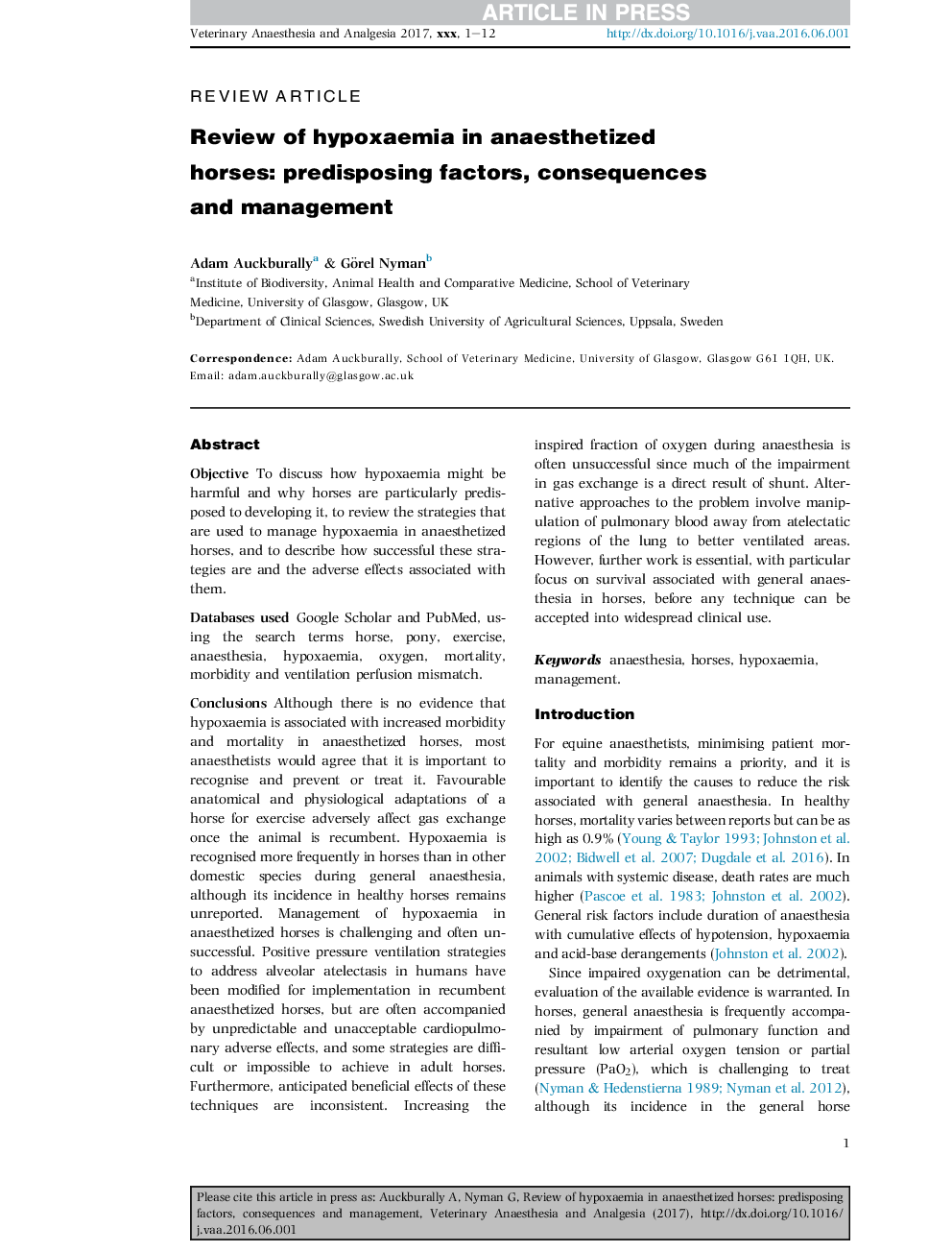| کد مقاله | کد نشریه | سال انتشار | مقاله انگلیسی | نسخه تمام متن |
|---|---|---|---|---|
| 10998406 | 1414381 | 2017 | 12 صفحه PDF | دانلود رایگان |
عنوان انگلیسی مقاله ISI
Review of hypoxaemia in anaesthetized horses: predisposing factors, consequences and management
ترجمه فارسی عنوان
بررسی هیپوکسائمی در اسبهای بیحسی: عوامل مستعد کننده، عواقب و مدیریت
دانلود مقاله + سفارش ترجمه
دانلود مقاله ISI انگلیسی
رایگان برای ایرانیان
کلمات کلیدی
بیهوشی اسبها هیپوکسیمی، مدیریت،
ترجمه چکیده
اگر چه هیچ شواهدی وجود دارد که نشان می دهد که هیپوکسمی همراه با افزایش میزان مرگ و میر در اسب های بیهوشی همراه است، اکثر بیهوشی ها موافقند که مهم است تشخیص و پیشگیری از آن یا درمان آن باشد. سازگاری آناتومیک و فیزیولوژیکی از یک اسب برای ورزش ناخوشایند بر مبادله گاز تا زمانی که حیوان در حال پرواز است، تاثیر می گذارد. در طول بیهوشی عمومی، هیپوکسمی بیشتر در اسب ها بیشتر از سایر گونه های داخلی شناخته می شود، هر چند که میزان آن در اسب های سالم هنوز گزارش نشده است. مدیریت هیپوکسیمی در اسب های بیهوشی چالش برانگیز است و اغلب ناموفق است. استراتژی های تهیه فشار مثبت برای مقابله با آتلکتازی آلوئولار در انسان برای پیاده سازی در اسبهای بیهوش تحتانی اصلاح شده است اما اغلب همراه با اثرات جانبی غیر قابل پیش بینی و غیر قابل قبول عوارض قلبی عروقی است و بعضی از استراتژی ها در اسب های بالغ دشوار یا غیرممکن است. علاوه بر این، اثرات مفید پیش بینی شده از این تکنیک ها متناقض است. افزایش فراوانی الهام گرفته از اکسیژن در طی بیهوشی اغلب ناموفق است، زیرا اغلب نقص در تبادل گاز نتیجه مستقیم شانت می باشد. رویکردهای جایگزین برای این مشکل عبارتند از دستکاری خون ریوی از مناطق متفاوتی از ریه تا مناطق تهویه مناسب. با این وجود، کارهای بعدی ضروری است، با تمرکز خاص بر بقای همراه با بیهوشی عمومی در اسب، قبل از اینکه هر گونه تکنیک را بتوان به طور بالقوه استفاده کرد.
موضوعات مرتبط
علوم زیستی و بیوفناوری
علوم کشاورزی و بیولوژیک
علوم دامی و جانورشناسی
چکیده انگلیسی
Although there is no evidence that hypoxaemia is associated with increased morbidity and mortality in anaesthetized horses, most anaesthetists would agree that it is important to recognise and prevent or treat it. Favourable anatomical and physiological adaptations of a horse for exercise adversely affect gas exchange once the animal is recumbent. Hypoxaemia is recognised more frequently in horses than in other domestic species during general anaesthesia, although its incidence in healthy horses remains unreported. Management of hypoxaemia in anaesthetized horses is challenging and often unsuccessful. Positive pressure ventilation strategies to address alveolar atelectasis in humans have been modified for implementation in recumbent anaesthetized horses, but are often accompanied by unpredictable and unacceptable cardiopulmonary adverse effects, and some strategies are difficult or impossible to achieve in adult horses. Furthermore, anticipated beneficial effects of these techniques are inconsistent. Increasing the inspired fraction of oxygen during anaesthesia is often unsuccessful since much of the impairment in gas exchange is a direct result of shunt. Alternative approaches to the problem involve manipulation of pulmonary blood away from atelectatic regions of the lung to better ventilated areas. However, further work is essential, with particular focus on survival associated with general anaesthesia in horses, before any technique can be accepted into widespread clinical use.
ناشر
Database: Elsevier - ScienceDirect (ساینس دایرکت)
Journal: Veterinary Anaesthesia and Analgesia - Volume 44, Issue 3, May 2017, Pages 397-408
Journal: Veterinary Anaesthesia and Analgesia - Volume 44, Issue 3, May 2017, Pages 397-408
نویسندگان
Adam Auckburally, Görel Nyman,
